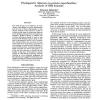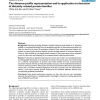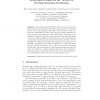148 search results - page 7 / 30 » The evolutionary capacity of protein structures |
ISMB
1998
13 years 8 months ago
1998
This workfocuses on the inference of evolutionary relationships in protein superfamilies, and the uses of these relationships to identify keypositions in the structure, to infer a...
BMCBI
2005
13 years 7 months ago
2005
Background: Detecting homology between remotely related protein families is an important problem in computational biology since the biological properties of uncharacterized protei...
BMCBI
2006
13 years 7 months ago
2006
Background: Owing to rapid expansion of protein structure databases in recent years, methods of structure comparison are becoming increasingly effective and important in revealing...
EVOW
2012
Springer
12 years 3 months ago
2012
Springer
Abstract. The hydrophobic-polar (HP) model for protein structure preabstracts the fact that hydrophobic interactions are a dominant force in the protein folding process. This model...
BMCBI
2010
13 years 7 months ago
2010
Background: Sequence alignments form part of many investigations in molecular biology, including the determination of phylogenetic relationships, the prediction of protein structu...



